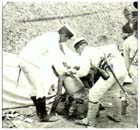 Attitudes to the war Pre-war Australian perception of the Japanese |
Corporal Jack Holmfield, 2/22nd Battalion AIF:
For a long, long time we didn't think that the Japanese were going to be anything anyway. We didn't really think the Japanese would be anything but, of course, we learnt very quickly.
Sergeant Bill Eliot, 53rd/54th Battalion AMF:
We were, we could see the writing on the wall, it was coming in closer. But we weren't actually that worried much because I don't think they realised like because ... well, we'd been told like, you know, I suppose it's [Singapore] impregnable, they can't get here and all that there. Anybody with a head on his shoulders could see that from island to island is just like walking across stepping stones, you can always get there. And, the Jap, he's no fool and a lot of people thought he was. All the propaganda, a little fellow with a big pair of glasses and a couple of buckteeth. My first Jap was six foot two, Mongolian (laughs).
Sergeant Jack Flanagan, 39th Battalion AMF:
I think most of us just had an idea that they were just little squibs and sort of no worry to us once we met them. But after we met them and we saw them we had to change our minds because they were fine strapping young men.
Flight Lieutenant Arthur Tucker, No. 75 (Fighter) Squadron RAAF:
I think the comment I would make now, and reading what the government had known for some years and Menzies' concern about Japan, I'm surprised that no one ever talked Japan to us. We never saw any reports of Japanese aircraft or tactics. I think it is true the tendency was to try to persuade us they were made of bamboo and spittle, and that the Japanese were short-sighted and couldn't see at night. I don't know whether those things were jokes or whether they were the ... what everyone was trying to believe, or whether somebody was trying to pull the wool over our eyes; but certainly I never saw anything technical on Japanese aircraft.
Sub-Lieutenant Bill Wreford, RAN:
We were told that the Japs were not a lot of consequence, you never saw a Jap who didn't wear glasses, they had primitive fire control on their ships. In actual fact, their fire control was bloody good, their torpedoes were faster, bigger, harder to detect, longer-range than anything the Allies had and, as fighters and as pilots, they were just damn good.
Captain Fred Field, 2/22nd Battalion AIF:
We thought they'd be treating you like ordinary normal prisoners of war. There was no thought otherwise.
Sergeant Alex Lochhead, 39th Battalion AMF and 2/2nd Battalion AIF:
Well, we didn't realise, or didn't know, the extent of the Japanese landing. We didn't know whether it was a large one or a small one. I think the general feeling was that once we got over the Owen Stanleys we could hold them and push them back into the sea. We were soon disabused of that theory when the remnants of B Company who had met the Japanese, came back through us as we got towards the other end - the north end - of the range.
Sergeant Victor Austin, 39th Battalion AMF and 2/2nd Battalion AIF:
By then what was the impression that you had as to the attitude of the Australians who were up on the Track regarding the Japanese. Earlier on the propaganda had been that they were terrible fighters, they were small, stunted and this and that and then they'd swept down and raced through south east Asia. What was, by this time, near the end of 1942, the attitude of the Australians towards the Japanese?
Oh naturally they had to totally revise that completely wrong opinion. Naturally they'd seen just how tough they were and how determined and they were opponents who you just couldn't underestimate...
Links
 Australian Attitudes
Australian Attitudes Pre-war perceptions
Pre-war perceptions  Fighting Ability
Fighting Ability  Atrocities
Atrocities  Japanese POWs
Japanese POWs  Atomic Bomb
Atomic Bomb  Post-war
Post-war
Attitudes links
| Overview | ||
| Australian Attitudes | ||
| Tamura diary | ||
| Southern Cross | ||
| Midget Submarine | ||
Click images to enlarge.

AWM P00044.063

AWM H13971

AWM P02887.001
The AJRP has wound up its activities at the Memorial for the moment. Please contact the relevant officer of the Australian War Memorial for assistance. Internet implementation by Fulton Technology and AJRP staff . Visit the Australian War Memorial home page. |